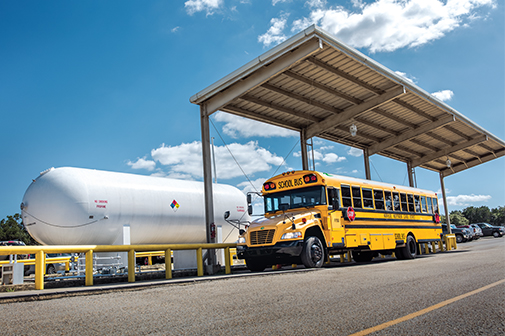Exploring new markets step by step
Q: What steps should propane retailers take before exploring new markets?
A:
A number of considerations should be addressed when entering into a new market. First, identify the type of market. Is the market primarily bulk residential, agriculture or industrial/commercial where there will be many 33-pound forklift accounts? Don’t forget the metropolitan areas with large dispenser accounts and 20-pound cylinder exchanges. Once the market is defined, understand if and how it will differ from your current operation.

Autogas is one market propane retailers can explore to build year-round gallons. Photo courtesy of the Propane Education & Research Council.
It’s important to set up a budget or forecast that outlines growth, margins and operating expenses, and incorporates capital expenditures. Create a monthly profit-and-loss statement for the first year and then an annual forecast for the next five and 10 years. More than likely, the new venture won’t make money the first year. Capital requirements will vary depending on the market, specifically the level of company tank ownership compared to customer-controlled business. A market that has a low number of company-owned tanks will require less capital than one with a high number of company-owned tanks.
Supply and demand will determine the growth rate and the margins to be obtained. An area with fewer retailers and a larger number of propane users should experience a higher growth rate and higher margins compared to an area with many retailers and fewer users. Ultimately, the growth rate and margins will determine when the new venture will become profitable.
While entering a new market can be exciting and may seem like the only path forward for growth, profitability is key to successful execution.
A retailer should look at the current pricing structure in the market through price shops so they know what to expect when entering a specific market.
Understanding the demand and number of potential customers in an area will allow decisions to be made that will affect the growth rate and margins. Keep in mind if you gain a customer on price, you will likely lose that same customer on price. Creating a marketing strategy that focuses on differentiating yourself from the current competition by providing value beyond price is the ideal way to gain customers.
It’s highly unlikely one retail propane marketer will capture 100 percent of the market share. The question is: How many different suppliers make up that market share, and can the area support another?
It’s also important to understand how operating expenses will change or differ from your current market. Are wage rates the same or similar for the new market versus your current market? Employee payroll and benefits generally account for 40 percent to 60 percent of total operating cost. How would drop sizes compare to current markets? Propane suppliers in the South have much smaller drops than companies in the North. These economics will determine if your pricing structure is feasible.
Finally, know the regulations. Each state has different rules about what is and isn’t allowed, which licenses are required, etc. Many states have special licenses that must be held by an individual, and many times that individual has to be at the specific location.
It’s important to realize when a venture isn’t working. Many years ago, a retailer started a home delivery business for 20-pound cylinders. People wanted the service, and the assumptions were right for pricing – customers were willing to pay more. However, the retailer misunderstood the cost to acquire a customer and could not gain enough customer density. In addition, the customer wanted to control the timing of delivery – they wanted delivery as soon as their tanks were empty. These important factors were considered initially but were greatly underestimated. Don’t get into a situation where you so strongly want the venture to work that you create answers to justify your model.
Cooper Wilburn is a consultant at Propane Resources.
















